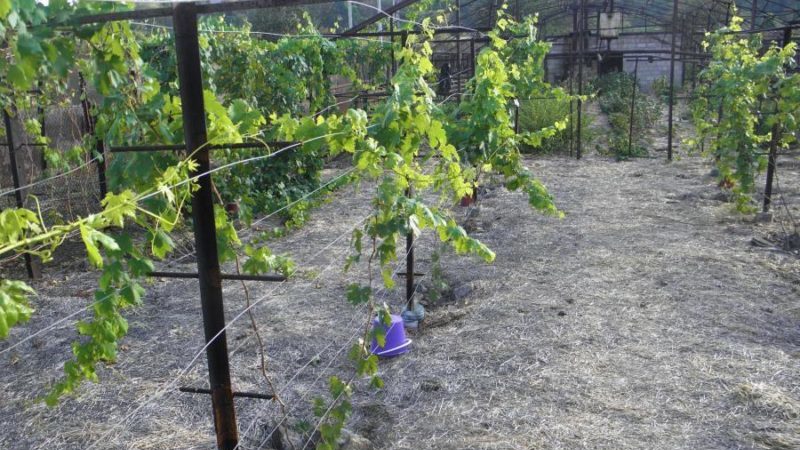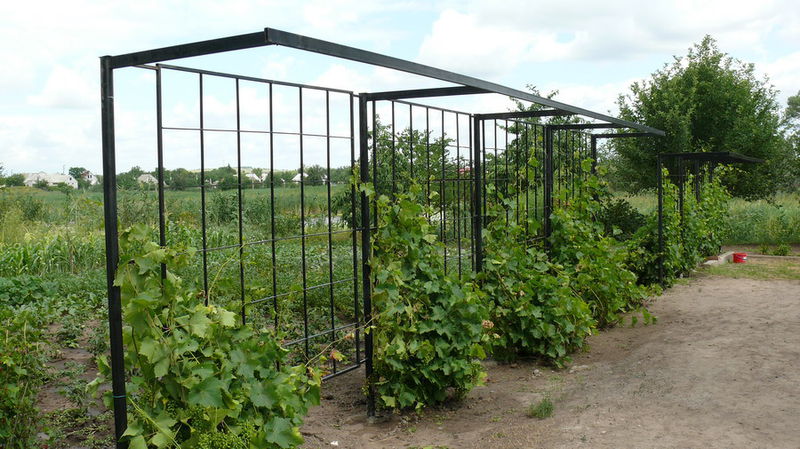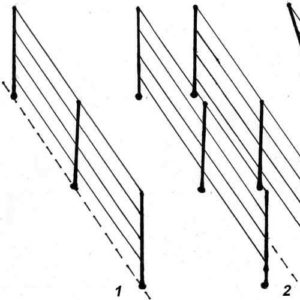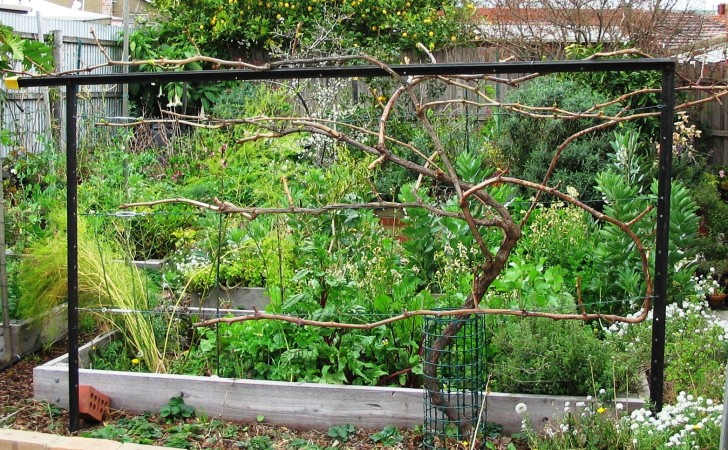Varieties and independent production of grape trellis
Grapes are a climbing culture with flexible and slender shoots. In order for the plant to develop correctly, not to break, to bear fruit abundantly, it needs support. It will protect the crop from damage and prevent berries from rotting in contact with the ground.
Tapestries for grapes are sold in specialized stores. However, buying enough items for a large vineyard is expensive. It is cheaper to assemble a frame of the correct size for plants with your own hands. What varieties are there and how to make a grape support yourself, read on.
The content of the article
The purpose of the trellis
The frame is required for the proper development of the grapes and the fixation of the shoots. Thanks to him, the branches are in an upright position and do not touch the ground.

Benefits of using a grape support:
- Air exchange. Due to the even distribution of branches over the support, the plant is ventilated from all sides.
- Reducing the risk of plant infection from shoots and pests... When in contact with the soil, the likelihood of spores of fungi and pests getting on the vine branches increases significantly. Constant ventilation, rapid evaporation of moisture create unfavorable conditions for the development of infection.
- Better lighting. Leaves and berries receive the same amount of light from all directions. This has a beneficial effect on the taste and quantity of berries, as well as the growth of the crop.
- Support. Grape shoots are flexible but thin. Without support, they will break under the weight of the fruit.
- Saving space. The vertical arrangement of vines allows you to create vineyards with your own hands, even in summer cottages and small suburban areas.
- Aesthetics. The vines on the trellis look beautiful and blend in with the garden landscape. With their help, the site is zoned.
- Convenience. It is easier to care for vines on trellises: in this position, the gardener can better see which shoots to remove and which ones to cure. It is more convenient to harvest from horizontal vines.
Material options for grape support

Grape grates are made from different materials. The table shows the main advantages and disadvantages of popular options.
| Material | Benefits | disadvantages |
| Wood | The most popular material for homemade tapestries, aesthetic and environmentally friendly. It is easy to work with, you can paint and cut decorative elements. | The tree rots and collapses under the influence of the environment. Pests start in it. To prevent this from happening, the supports are coated with varnish or special impregnations. |
| Metal | Metal trellises are strong and durable. They are not afraid of mechanical stress, they look modern. | The creation of complex supports from this material requires a welding machine and related skills. Simple structures simply dig into the ground, but look less aesthetically pleasing. The metal is susceptible to corrosion, so it must be painted, choose galvanized or polymer-coated options. It is allowed to use profile metal posts. |
| Plastic | A trellis structure made of plastic pipes is the cheapest option. They are not susceptible to fungi, bacteria, pests. | Such structures are short-lived, easily break down under physical impact, and can be torn out by strong winds. Under constant exposure to ultraviolet light, they fade, become unaesthetic. They are not environmentally friendly. |
| Asbestos cement | Strong, durable support.Easily tolerates physical impact. | It looks less aesthetically pleasing than wood and metal. |
In addition to pillars, to create a trellis, you will need a wire (preferably copper), which is pulled between the elements. It is on it that the vines twine.
The wire is attached to the posts in different ways. In some cases, special fasteners are required. You will need concrete to install the pillars. Without this, the grape trellis will not last long.
It is interesting:
How to make a support for grapes with your own hands
There are several types of grape racks:
- one-plane;
- two-plane;
- L-shaped;
- decorative.
Each trellis is designed for both one plant and a whole row. In the second case, several rows of supports are compactly placed. Grapes of a certain variety are planted in one row. Different varieties of this culture have differences in care.
The easy way to create a one-plane strut
A single-plane trellis is a group of pillars located at the same distance from each other, with one or more metal wires stretched between them... The structure got its name because the vines attached to it are located in one plane.
This grape stand has the simplest blueprint possible. Even a person who is far from construction work can cope with its manufacture. To assemble the trellis, you will need wire, poles and tools for their processing (for certain materials).
Reference. Grapes on a single-plane stand are easy to prune and cover for the winter. Each shoot will be in full view of the gardener. Structures do not take up much space, do not create a large shadow Flowers or herbs are often planted between them.
The single-plane trellis is not suitable for all grape varieties. Powerful, sprawling plants with several arms are difficult to place on such a support. In this case, there is a high risk of plant thickening, which will cause a decrease in yield and crop disease.
The optimal height of the posts for the trellis is 2 m. Sometimes structures with a height of 1.8 to 3 m are erected. The diameter of the side posts should not be less than 15 cm. For central elements, the optimal size is 7–10 cm.
Wire thickness varies within 2-3 mm. Aluminum, copper, galvanized products are suitable. Experienced gardeners recommend choosing galvanized wire, as copper and aluminum materials are often stolen.
Step-by-step instructions for making a single-plane rack for grapes:
- Prepare the posts. The part that will go underground is treated with protective compounds. Bitumen is used for metal products. Wooden pillars are soaked in a 5% solution of copper sulfate for 10 days.

- Dig holes 1 m deep.The distance between them should be from 4 to 6 m.The distance between the rows is kept at least 100 cm.
- Pillars are inserted into the wells with the processed part down. They are buried, layer by layer, tamping the ground. Some gardeners are pouring concrete into the load-bearing elements.
- Some of the supports located above the ground are processed. The metal is colored. Wooden elements are impregnated with special agents or varnished.
- A wire is pulled between the posts, preferably in 3-5 rows. The bottom row should be at least 40 cm from the ground. Leave 35–45 cm between the rows. To secure the wire, use staples, nails or rings made of the same wire.
Vineyards of different heights and lengths are made according to this scheme. The main thing is to pay enough attention to each stage.
This option is optimal for covering non-spreading varieties. Summer residents or owners of small plots prefer to use it.
Two-plane frame
Two-plane supports accommodate more shoots.Such structures consist of 2 single-plane trellises connected to each other.
Two-plane trellis are highly durable. They can support the weight of even thick and heavy branches. It is convenient to place shoots of spreading varieties on them. This option is suitable for shade-tolerant frost-resistant varieties that do not cover for the winter. Supports with two planes are chosen by owners of large vineyards.
Two-plane trellis are more difficult to assemble than single-plane ones. To fix them, you will need a concrete composition.
Method for making a two-plane trellis:
- The pillars are treated with protective compounds. The part that will be underground is covered with bitumen (for metal elements) or soaked in a solution of copper sulfate (for wooden products). The upper part of the post is covered with paints and varnishes or impregnated with protective agents.
- Dig holes 50 cm deep and 30 cm in diameter parallel to each other every 80 cm. Several such groups are made at a distance of 4–6 m.
- They are inserted into the pits along a pipe at an angle so that a distance of 120 cm is maintained between the upper ends of the elements of each group. The position is fixed with rubble. You should get a wedge measuring 80 cm at the bottom and 120 at the top.
- Cement is poured into the pits. The solution is allowed to solidify completely.
- The wire is pulled between the rows on both sides of the wedges at a distance of 50 cm from each other. The height from the ground to the first row should be 60 cm. To fix the wire, holes are drilled in the wooden posts, and special hooks and brackets are installed on the metal ones.
L-shaped trellis

L-shaped trellis is one of the types of single-plane structures. Its peculiarity lies in the fact that the pillars resemble the letter G.
This support is used for grapes with high vigor. This is a good alternative for spreading crop varieties in small areas.
The easiest way to make a structure is wood. Welding is required to create a metal corner support.
How to make an L-shaped trellis:
- Wooden pillars are soaked in a solution of copper sulfate for 10 days. Then they are painted, varnished or special antibacterial impregnation.
- They dig holes 50 cm deep and 30 cm in diameter. A distance of 4–6 m is kept between them.
- Pillars are installed in the pits perpendicular to the surface of the earth. They are fixed with crushed stone, poured with a cement composition. The concrete is allowed to dry and harden.
- Wire is pulled in rows between the L-shaped pillars. The lower one should be at a height of 40-50 cm from the ground, the distance between the others should be 35-60 cm.
- A wire is also pulled between the parts of the pillars that are parallel to the ground. Usually 3 rows are made at equal distance from each other.
Features of decorative trellis for grapes

Decorative tapestries have a more complex design. They not only organically fit into the landscape of the garden, but also decorate it.
Mostly such supports are used for decorative grape varieties, for example, maiden. Sometimes used for tall, spreading varieties of fruitful crops.
Such structures can withstand heavy loads. They are made in the form:
- arbors;
- fences;
- arches;
- gratings, etc.
Often a balcony acts as a decorative trellis. Sometimes gratings are attached directly to the wall of the house.
The disadvantages of such options are cumbersome, manufacturing complexity, high cost. However, they are not able to provide support for a large number of plants.
It is interesting:
How to make a grape pergola with your own hands
What are the sheds for grapes and how to make them yourself
How to water and feed grapes in spring: instructions for beginners
Conclusion
Without the trellis, the grape vines will end up on the ground. This will cause it to become infected with diseases and damage by pests, reduce yields, rotting berries, and deteriorate air circulation.
Vine supports not only perform practical functions, but also decorate the site. You can make them yourself using a drawing.